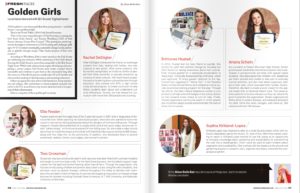Local teens honored with Girl Scouts’ highest honor
Local teens honored with Girl Scouts’ highest honor.
By Alison Bailin Batz
All that glitters is not always gold, but these young women––and their futures––are sparkling bright.
They’re the North Valley’s 2016 Gold Award honorees.
“One of the most impactful parts of Girl Scouting is earning the Girl Scout Gold Award,” says Tamara Woodbury, CEO of Girl Scouts–Arizona Cactus-Pine Council. “This prestigious award represents the highest achievement in Girl Scouting and challenges girls ages 14–17 to initiate meaningful, sustainable change locally, nationally, or globally through unique ‘Take Action’ projects of their own creation.”
According to Woodbury, 2016 is extra-special as the Girl Scouts are celebrating the milestone 100th anniversary of the Gold Award. Earning the Gold Award is somewhat comparable to the Boy Scouts’ Eagle Scout. While both achievements require developing and completing a service project, Girl Scouts must create a project that is sustainable and continues to give back to the community long after she moves on. Overall, the process usually takes 18 to 24 months and often involves seeking in-kind donations and recruiting volunteers.
Others recognize the value of the Gold Award, too. Some universities and colleges offer scholarships to award recipients and girls who enlist in the U.S. armed forces may receive advanced rank in recognition of their achievements.
Here is a snapshot of these golden girls in action:
Rachel De Stigter
After DeStigter witnessed her friend, an exchange student from Italy, dealing with bullies, she was inspired to take action. After some research, she found that xenophobia, an irrational dislike of people from other countries, is typically caused by ignorance of other cultures. Her Gold Award project focused on breaking down cultural barriers through education. She worked with AFS, a high school study abroad program, to create curriculum to help fellow students learn about and understand cultural differences. Overall, she has shared her curriculum with more than 200 people and counting.
Ellie Fessler
Fessler experienced the tragic loss of her 2-year-old cousin in 2007 after a large piece of furniture fell over. When planning her Gold Award project, she knew she wanted to honor her cousin’s memory by raising awareness about the dangers of furniture falling over. Through research, Fessler discovered that for a couple dollars and a few quick steps, anyone can install “safety straps” on furniture to prevent it from falling over. So, she made a video tutorial about how to install the straps and worked with Safe Kids Maricopa to distribute 500 straps, along with the video link, to the community. In addition, she distributed flyers to several preschools, realtors, family court judges, and women’s centers.
Tess Grossman
Grossman was born profoundly deaf in both ears and was later fitted with cochlear implants and taught to communicate orally. For her Gold Award project, she founded a support organization for the deaf and hard-of-hearing called Hear & Now. Through the organization, she focuses on educating children and parents about deaf culture, living life with a disability, and services––such as speech therapy––offered throughout the Valley to families with members who are deaf or hard-of-hearing. Grossman also began giving auditorium-based college lectures for schools including Colorado State University, A.T. Still University, and Gallaudet University on the topic.
Brittanee Hustad
In 2014, Hustad lost her best friend to suicide. She turned her grief into positive change by focusing her Gold Award on raising awareness about teen suicide. First, Hustad applied for a statewide proclamation to make Sept. 10 Suicide Awareness Day in Arizona, which was approved. To bring greater attention to the day, Hustad then organized a “Yellow Out” in the Paradise Valley Unified School District and initiated an online suicide awareness-training program for the area. Through her efforts, the Teen Lifeline telephone number is now printed on all high school ID badges in the school district so that students know where to turn for help. Finally, Hustad organized a community event in which attendees could learn about suicide and remember the lives of those lost to suicide.
Ariana Schein
As a student at Desert Mountain High School, Schein joined a peer leadership club whose purpose was to participate in extracurricular activities with special needs students. She discovered that children with disabilities are often isolated and unable to take part in everyday normal activities, and also had added expenses related to their care, which excluded them further. Schein, therefore, decided to create a prom closet for the special needs kids at Hacienda Health Care. The closet allows patients to borrow dresses so they can attend the prom hosted by the organization. Schein organized and held a drive to collect dresses, and collected donations for other items like racks, hangars, and make-up. She collected almost 100 dresses.
Sophia Kirkland-Lopez
Kirkland-Lopez was inspired to take on a Gold Award project when she noticed a dilapidated wall at her church, St. Joan of Arc. More than simply wanting to repair it, Kirkland-Lopez wanted to use the space as an opportunity to increase knowledge about gardening and sustainability by transforming the wall into a raised garden, which could be used to teach children about vegetation and sustainability. She worked with the leaders at the church and gardening experts to research, plan, organize volunteers, and build the now-gorgeous garden.
Related posts
Leave a Comment
You must be logged in to post a comment.







